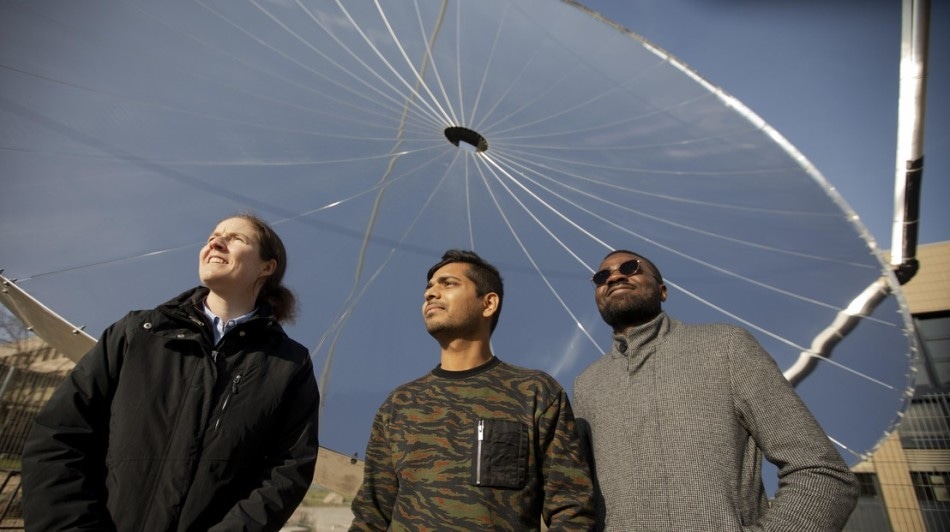Apr 30 2019
Scientists at EPFL have developed a smart device that has the ability to produce enormous amounts of clean hydrogen.
 Sophia Haussener, Saurabh Tembhurne, and Fredy Nandjou (Image credit: Marc Delachaux/2019 EPFL)
Sophia Haussener, Saurabh Tembhurne, and Fredy Nandjou (Image credit: Marc Delachaux/2019 EPFL)
Despite using a lesser amount of the rare, expensive materials for producing hydrogen using bright sunlight, their device retains a high solar-to-fuel efficiency. Their investigation has been enhanced with a pilot facility established at the EPFL campus.
Hydrogen can play an important role in minimizing the demand for fossil fuels. It can be renewably produced by splitting water molecules using solar energy. As a result, the clean energy can be stored, used to fuel cars, or converted into electrical energy on demand.
However, producing it extensively in a reliable manner and at low cost is a challenge for the scientists. Rare and costly materials are required to produce efficient solar hydrogen—for the catalyst and solar cells—to collect energy and to convert it later.
Researchers at EPFL’s Laboratory of Renewable Energy Science and Engineering (LRESE) planned to concentrate solar irradiation for producing more hydrogen over a specific area at low cost. They created an optimized photo-electrochemical system with the ability to convert solar power into hydrogen at a conversion rate of 17% as well as remarkable power and current density when used together with smart thermal management and concentrated solar irradiation. Furthermore, their method is stable and can deal with the stochastic dynamics of everyday solar irradiation.
The study has been published in Nature Energy.
In our device, a thin layer of water runs over a solar cell to cool it. The system temperature remains relatively low, allowing the solar cell to deliver better performance.
Saurabh Tembhurne, Study Co-author, LRESE, EPFL.
At the same time, the heat extracted by the water is transferred to catalysts, thereby improving the chemical reaction and increasing the hydrogen production rate.
Fredy Nandjou, Researcher, LRESE, EPFL.
Hence, the production of hydrogen is optimized at every conversion process step.
Using the unique solar simulator at LRESE, the researchers showed the stable performance of their device. The results from the laboratory-scale demonstrations were so successful that the device has been improved and is currently being tested in the open air, at the EPFL campus in Lausanne. The scientists installed a parabolic mirror with a diameter of 7 m, which can concentrate solar irradiation by a factor of 1000 and drive the device. The initial tests are in progress.
Hydrogen Stations
The researchers estimated that their device has the potential to operate for more than 30,000 hours—or about 4 years—without any replacement of parts and up to 20 years if few parts are replaced every 4 years. To increase its yield, their solar concentrator turns and follows the sun across the sky.
In sunny weather, our system can generate up to 1 kilogram of hydrogen per day, which is enough fuel for a hydrogen-powered car to travel 100 to 150 kilometers.
Sophia Haussener, Project Lead, LRESE, EPFL.
Sophia Haussener is also the head of the LRESE.
For the production of distributed, large-scale hydrogen, many concentrator systems could be used collectively to generate hydrogen for hydrogen stations or at chemical plants. Tembhurne and Haussener have aimed to carry their technology from the laboratory to industry in collaboration with a spin-off company called SoHHytec.
Open Source Software
Using an open interface, it was possible to monitor the instantaneous performance of the system.
In their research, the researchers also carried out a technological and economic feasibility study and created an open-source software program called Solar PhotoElectroChemical Device Optimization (SPECDO; http://specdo.epfl.ch). This program could possibly help engineers to design components for inexpensive photoelectrochemical systems to produce solar hydrogen. In addition, they made available a dynamic benchmarking tool called Solar PhotoElectroChemical Device Comparison (SPECDC), for the assessment and comparison of all photoelectrochemical system demonstrations.
Funding
This study was supported by the NanoTera project SHINE and the SNFS Starting Grant SCOUTS; the scale-up was financially supported by SNSF-Bridge, the Swiss Federal Office of Energy, and EPFL.
Record solar hydrogen production with concentrated sunlight
(Video credit: EPFL)